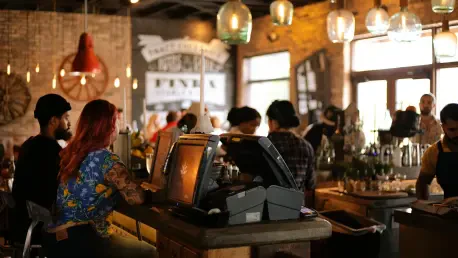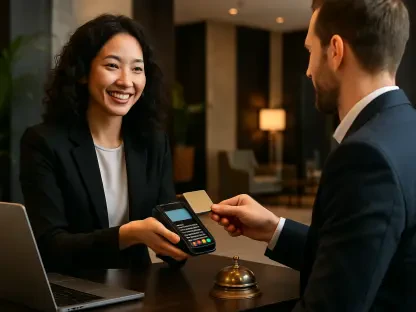In an era where technology drives innovation across industries, the restaurant sector has seen a surge in mobile-order and pickup-only formats, heralded as the future of dining efficiency by major brands like Starbucks, which promised to cut wait times, reduce staffing needs, and cater to a fast-paced, digital-savvy clientele. Yet, the recent wave of closures and conversions of such stores reveals a stark reality: many fail to resonate with customers on a deeper level. While the allure of streamlined operations is undeniable, the absence of personal connection and perceived value often leaves patrons underwhelmed. This article delves into the multifaceted reasons behind the struggles of mobile-order-only restaurants, drawing on expert insights and industry trends to highlight why prioritizing speed over experience can erode brand loyalty. From economic pressures to missed market segments, the challenges are complex, pointing to a need for a more balanced approach in the evolving landscape of dining.
Clash of Convenience and Connection
The fundamental flaw in mobile-order-only restaurant models often lies in the tension between operational efficiency and the human touch that defines dining. Industry leaders, such as Starbucks’ CEO Brian Niccol, have publicly acknowledged that these formats can feel overly transactional, stripping away the warmth and premium experience customers associate with established brands. During a recent earnings discussion, Niccol emphasized that such stores miss the mark on delivering the hospitality that loyal patrons expect. This sentiment resonates with broader industry observations, suggesting that while the model addresses logistical pain points like long queues and order management, it sacrifices the emotional engagement that turns a quick coffee run into a cherished ritual. Customers, after all, seek more than just a product; they crave an interaction that justifies their spending, especially when alternatives abound in a competitive market.
Further exploring this disconnect, experts like Ming-Tai Huh from Square underscore that many consumers balk at paying premium prices for what feels like a cold, impersonal exchange. The mobile-order-only setup, designed to maximize throughput, often reduces the dining experience to a mere transaction, devoid of the social or sensory elements that elevate a brand. This is particularly problematic for chains that have built their reputation on creating a welcoming “third place” between home and work. When the focus shifts entirely to speed, the risk of alienating a customer base that values ambiance and service grows significantly. The data supports this concern, as feedback consistently shows dissatisfaction with the lack of personal touch in digital-only interactions, highlighting a gap that technology alone cannot bridge in the hospitality sector.
Economic Realities Undermining Value
Amid today’s economic landscape, where rising costs and stagnant wages shape consumer behavior, mobile-order-only restaurants face heightened scrutiny over their value proposition. As Robert Byrne, a senior director at Technomic, points out, customers are increasingly selective about their spending, seeking not just affordability but a meaningful return on their investment in a dining experience. In a mobile-only setting, where interaction is minimal and the environment feels utilitarian, justifying higher price points becomes a steep challenge. Byrne describes this as a “commoditization of the brand,” where the lack of experiential depth makes the offering feel no different from a generic, low-cost alternative. This perception erodes the premium positioning that many chains rely on to maintain profitability.
Adding to this economic strain, the mobile-order-only model struggles to adapt to a market where value is defined by more than just price. Consumers often equate value with a holistic experience—think friendly staff, inviting spaces, or even a moment of respite during a busy day. When these elements are absent, as they often are in a pickup-only format, the transaction feels hollow, failing to meet expectations set by traditional dining or even hybrid models. Research indicates that patrons are less likely to return to brands that prioritize efficiency over engagement, especially when budgets are tight. This dynamic reveals a critical oversight in the mobile-only approach: underestimating the importance of emotional satisfaction in driving repeat business, particularly in an era when every dollar spent is carefully considered.
Exclusion of Diverse Customer Bases
A significant operational limitation of mobile-order-only formats is their tendency to exclude entire segments of the population, narrowing their market reach. Byrne from Technomic highlights that by relying solely on digital transactions, restaurants alienate groups such as older adults, low-income individuals, and those less comfortable with or unable to access technology. This is especially notable given the rapid growth of the 65-and-older demographic in the U.S., a group with considerable spending power yet often overlooked by digital-first strategies. Such exclusion not only limits immediate sales but also hampers long-term customer acquisition, as these groups represent untapped potential in an increasingly competitive industry.
Beyond demographic exclusion, the mobile-only model stifles opportunities for spontaneous engagement, a key driver of growth for restaurant brands. Customers who might stumble upon a location and decide to try it on a whim are deterred by the need to pre-plan through an app, reducing the likelihood of capturing first-time visitors. This lack of spontaneity also impacts the promotion of limited-time offers, which data shows are twice as likely to be ordered by newcomers. By cutting off these organic touchpoints, mobile-order-only formats miss out on building a broader customer base, a critical misstep in a market where differentiation often hinges on accessibility and discovery. The result is a self-imposed barrier that restricts both revenue and brand expansion.
Risks to Brand Integrity
The impact of mobile-order-only models on brand reputation presents another layer of concern for restaurant operators. Contrary to the intent of improving efficiency, guest experience metrics for digital orders often fall below those of traditional interactions, even in areas like speed of service, as Byrne notes. This discrepancy suggests that the format not only fails to deliver on its core promise but also risks disappointing customers who associate a brand with a certain standard of quality. For a chain like Starbucks, known for its elevated service and ambiance, subpar digital experiences can erode trust and loyalty, creating a ripple effect across the entire customer base.
Moreover, the damage to brand perception extends beyond individual transactions to influence long-term market positioning. When digital orders consistently underperform in customer satisfaction surveys, the negative feedback can overshadow a brand’s broader strengths, painting it as out of touch with consumer desires. This is particularly risky in an industry where word-of-mouth and online reviews heavily shape public opinion. A format intended to modernize operations can inadvertently signal a shift away from hospitality, alienating patrons who value personal connection over convenience. Over time, such missteps can weaken a brand’s standing, making recovery a costly and complex endeavor in a crowded field.
Viability in Niche Markets and Hybrid Solutions
Despite widespread challenges, mobile-order-only formats are not entirely without potential, particularly in specific high-traffic environments where speed trumps all. Experts like Ming-Tai Huh and Aaron Allen of Aaron Allen & Associates suggest that locations such as transit hubs or college campuses—where grab-and-go is the norm—can sustain this model effectively. Brands with a digitally native customer base, like Sweetgreen, often fare better in these settings due to their urban focus and app-centric behavior. However, even in these contexts, success hinges on aligning the format with customer expectations for quick, seamless service rather than a full dining experience, underscoring the niche nature of its applicability.
The broader industry consensus, however, leans toward hybrid or omnichannel solutions that blend digital convenience with traditional touchpoints. Innovations like dedicated mobile-order drive-thru lanes at chains such as Chipotle demonstrate how technology can enhance efficiency without sacrificing other customer interactions. This “mobile-also” rather than “mobile-only” mindset, as Allen advocates, prioritizes flexibility, ensuring that brands cater to diverse needs without alienating key segments. The shift reflects a growing recognition that while digital tools are indispensable, they must complement rather than replace the human element of hospitality, preserving the experiential value that keeps customers coming back.
Adapting for Future Relevance
Looking at strategic responses, Starbucks’ recent moves offer a glimpse into how the industry is recalibrating to address the shortcomings of mobile-order-only models. Plans to introduce new store formats by 2026, featuring off-premise dining alongside seating and enhanced service at reduced build costs, signal an intent to merge convenience with connection. These designs aim to cater to the demand for speed while restoring the personal engagement that defines brand loyalty. This pivot mirrors a wider trend among restaurant operators to rethink how technology integrates into the dining experience, ensuring it serves as an enabler rather than a barrier to customer satisfaction.
Beyond specific brand strategies, the push for adaptability underscores a critical lesson for the sector: understanding and meeting customer desires must take precedence over cost-cutting alone. As economic conditions and consumer preferences continue to evolve, restaurants must remain agile, leveraging digital advancements to streamline operations while safeguarding the hospitality that sets them apart. The path forward lies in crafting experiences that resonate on both practical and emotional levels, ensuring that value is delivered not just through a product but through every interaction. This balance will be pivotal for sustaining relevance in a dynamic and competitive market.









